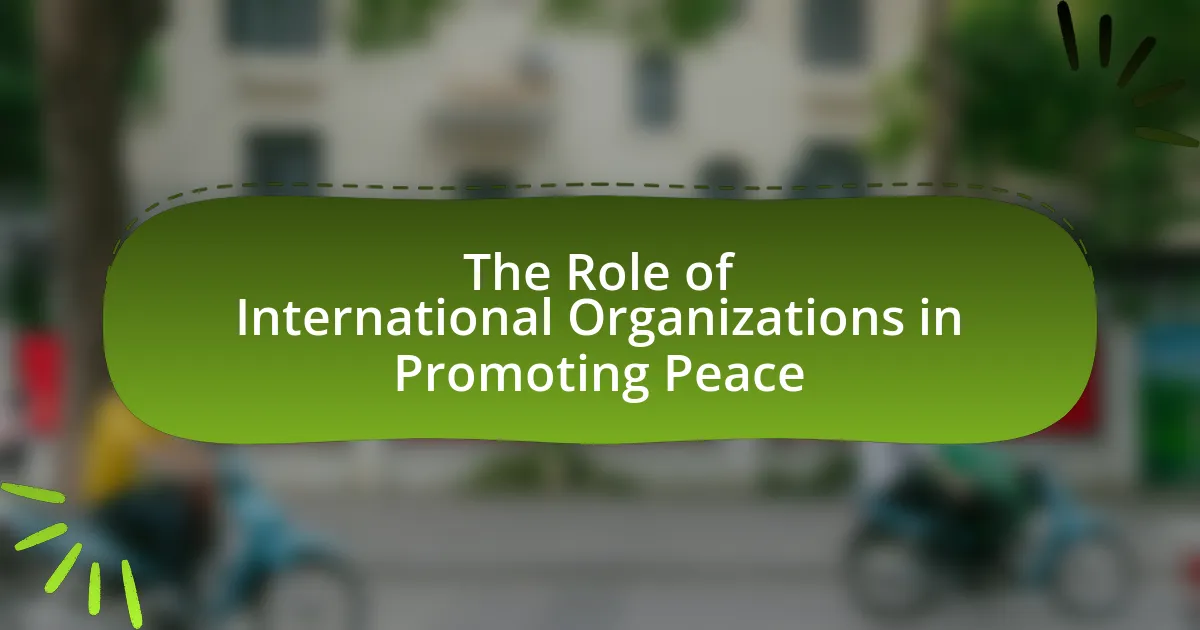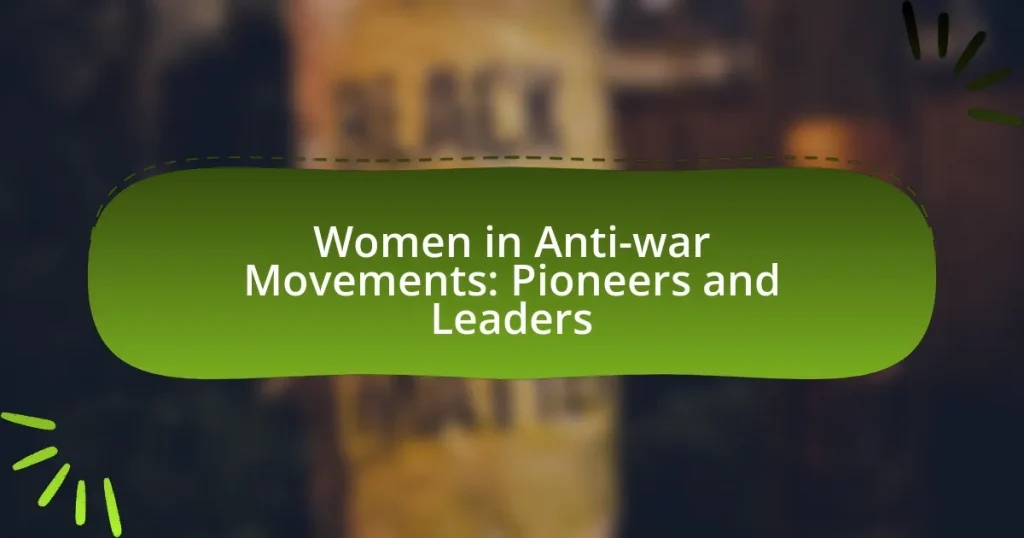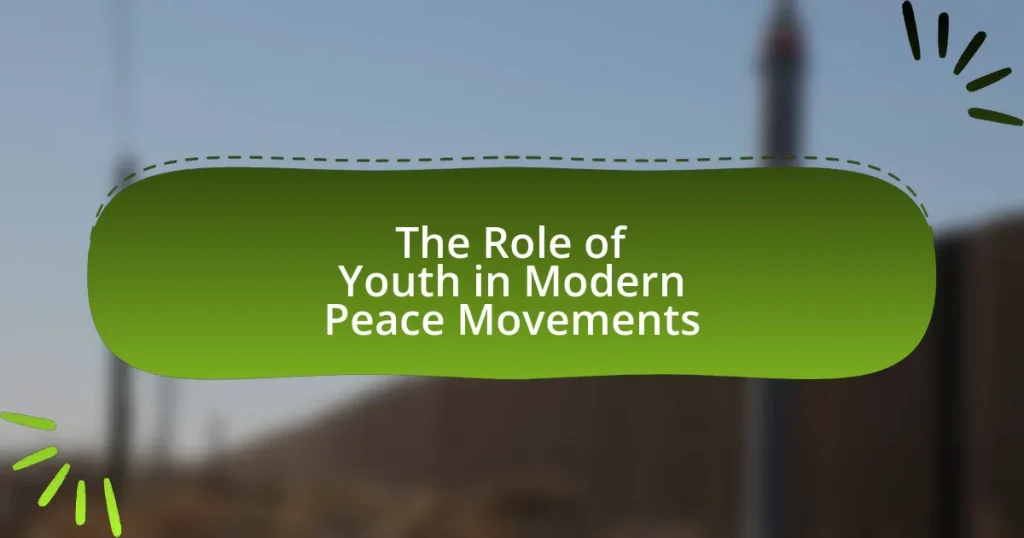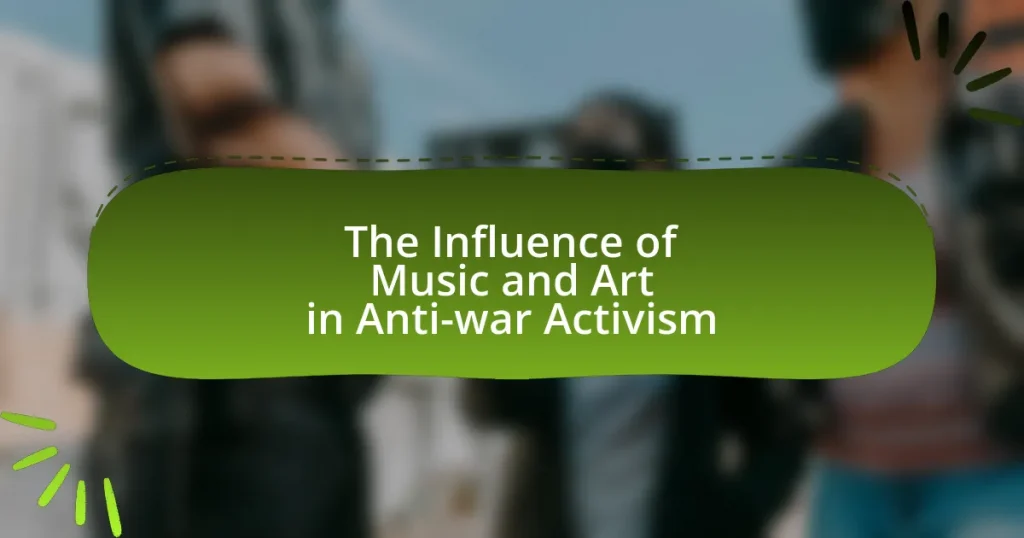International organizations, such as the United Nations and the Organization for Security and Co-operation in Europe, play a vital role in promoting peace through conflict resolution, peacekeeping missions, and fostering international cooperation. They facilitate dialogue among nations, mediate disputes, and provide humanitarian assistance, which are essential for sustainable peace. The article explores the functions and contributions of these organizations, the challenges they face, and the importance of collaboration with local communities and civil society in peace initiatives. It also highlights the historical contexts that underscore the necessity of international organizations in maintaining global peace and security.
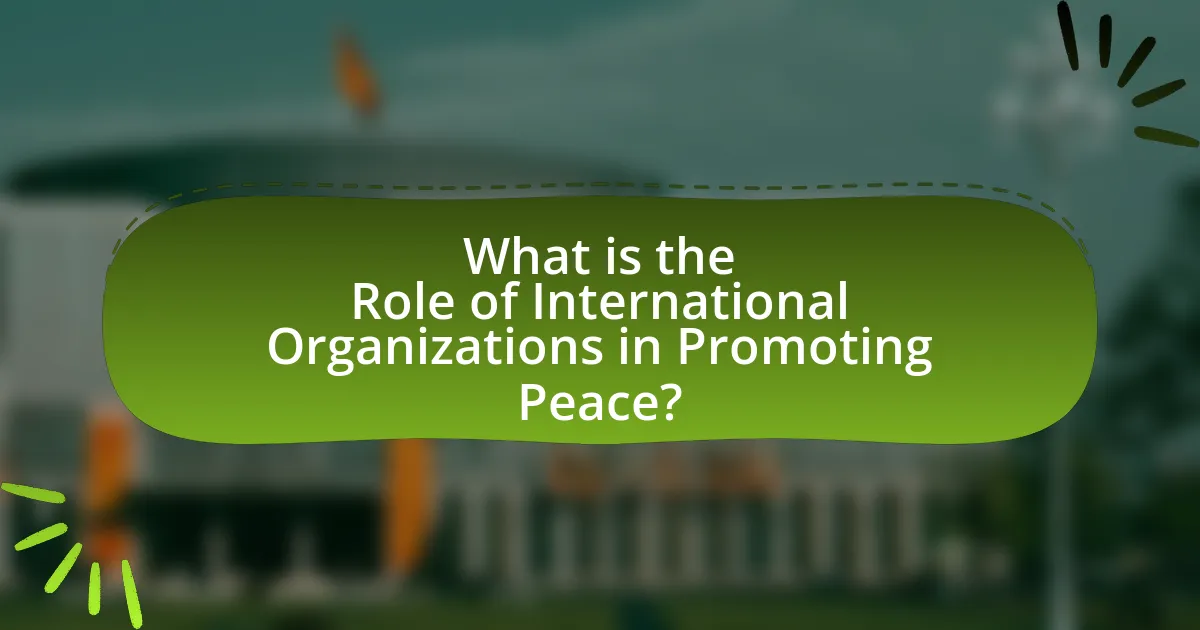
What is the Role of International Organizations in Promoting Peace?
International organizations play a crucial role in promoting peace by facilitating dialogue, mediating conflicts, and providing platforms for cooperation among nations. For instance, the United Nations (UN) engages in peacekeeping missions, which have been deployed in various regions, such as the UN Peacekeeping Force in Cyprus, established in 1964, to maintain ceasefires and prevent further hostilities. Additionally, organizations like the Organization for Security and Co-operation in Europe (OSCE) work to enhance security and stability through diplomatic efforts and monitoring missions. These organizations also provide humanitarian assistance and support post-conflict reconstruction, which are essential for sustainable peace. Their efforts are backed by international treaties and resolutions, such as the UN Charter, which emphasizes the importance of collective security and peaceful dispute resolution.
How do international organizations contribute to global peace efforts?
International organizations contribute to global peace efforts by facilitating diplomacy, providing conflict resolution mechanisms, and deploying peacekeeping missions. For instance, the United Nations (UN) plays a crucial role in mediating disputes between nations, exemplified by its involvement in the Camp David Accords, which helped broker peace between Egypt and Israel in 1978. Additionally, organizations like the Organization for Security and Co-operation in Europe (OSCE) offer platforms for dialogue and negotiation, which have been instrumental in de-escalating tensions in Europe. Furthermore, peacekeeping missions, such as those conducted by the UN, have been deployed in various conflict zones, including in Liberia and Sierra Leone, to maintain stability and protect civilians, demonstrating their effectiveness in promoting peace.
What are the primary functions of international organizations in peace promotion?
International organizations primarily function in peace promotion through conflict resolution, peacekeeping operations, and fostering international cooperation. They mediate disputes between nations, as seen in the United Nations’ role in various peace negotiations, such as the Camp David Accords in 1978. Additionally, these organizations deploy peacekeeping forces to maintain stability in conflict zones, exemplified by the UN Peacekeeping missions in countries like Rwanda and the Democratic Republic of the Congo. Furthermore, they promote dialogue and collaboration among member states to address root causes of conflict, illustrated by initiatives like the Organization for Security and Co-operation in Europe (OSCE) facilitating discussions on security and cooperation in Europe.
How do these functions vary among different organizations?
Functions of international organizations in promoting peace vary significantly based on their mandates, structures, and operational contexts. For instance, the United Nations focuses on diplomatic negotiations and peacekeeping missions, while regional organizations like the African Union emphasize conflict prevention and resolution tailored to local dynamics. Additionally, non-governmental organizations often engage in grassroots advocacy and humanitarian assistance, which complements the efforts of formal entities. This variation is evident in the differing approaches to peacebuilding, where the UN may deploy peacekeepers in conflict zones, whereas NGOs might prioritize community-based reconciliation initiatives. Such distinctions highlight how organizational objectives and regional contexts shape their peace-promoting functions.
Why is the involvement of international organizations crucial for peace?
The involvement of international organizations is crucial for peace because they facilitate dialogue, provide mediation, and establish frameworks for conflict resolution. These organizations, such as the United Nations, have a mandate to promote peace and security globally, which is evidenced by their role in peacekeeping missions and conflict prevention initiatives. For instance, the UN has deployed over 70 peacekeeping operations since its inception, demonstrating its commitment to maintaining international peace and security. Additionally, international organizations often bring together diverse stakeholders, enabling collaborative approaches to address the root causes of conflicts, thereby fostering long-term stability.
What historical contexts highlight the need for international organizations in peacekeeping?
The historical contexts that highlight the need for international organizations in peacekeeping include the aftermath of World War II, the Cold War, and the conflicts in the Balkans during the 1990s. Following World War II, the establishment of the United Nations in 1945 aimed to prevent future conflicts and promote international cooperation, reflecting the global desire for peace after the devastation of the war. During the Cold War, numerous proxy wars and regional conflicts underscored the necessity for a neutral entity to mediate disputes and maintain stability, leading to the UN’s increased involvement in peacekeeping missions. The violent breakup of Yugoslavia in the 1990s further demonstrated the urgent need for international organizations to intervene in ethnic conflicts and humanitarian crises, resulting in significant UN peacekeeping operations to restore order and protect civilians. These historical events collectively illustrate the critical role of international organizations in addressing global peace and security challenges.
How do international organizations facilitate conflict resolution?
International organizations facilitate conflict resolution by providing platforms for dialogue, mediation, and negotiation among conflicting parties. These organizations, such as the United Nations, often deploy peacekeeping missions and offer diplomatic resources to help de-escalate tensions. For instance, the UN has successfully mediated numerous conflicts, including the peace agreements in El Salvador and Mozambique, demonstrating their effectiveness in fostering communication and compromise. Additionally, international organizations can impose sanctions or offer incentives to encourage compliance with peace agreements, further reinforcing their role in conflict resolution.

What types of international organizations are involved in peace promotion?
International organizations involved in peace promotion include the United Nations, regional organizations like the African Union and the European Union, and non-governmental organizations such as the International Crisis Group. The United Nations plays a central role through its peacekeeping missions and diplomatic efforts, having conducted over 70 peacekeeping operations since its inception in 1948. The African Union has engaged in conflict resolution and peacekeeping in various African nations, while the European Union promotes peace through its Common Security and Defense Policy. Non-governmental organizations contribute by advocating for peace, providing humanitarian assistance, and facilitating dialogue in conflict zones.
What are the main categories of international organizations focused on peace?
The main categories of international organizations focused on peace include intergovernmental organizations, non-governmental organizations, and regional organizations. Intergovernmental organizations, such as the United Nations, play a crucial role in conflict resolution and peacekeeping through various missions and diplomatic efforts. Non-governmental organizations, like the International Crisis Group, contribute by advocating for peace and providing on-the-ground support in conflict zones. Regional organizations, such as the African Union, focus on peace and security within specific geographic areas, often facilitating dialogue and mediation efforts among member states. These categories collectively enhance global peace initiatives through diverse approaches and strategies.
How do governmental organizations differ from non-governmental organizations in their peace efforts?
Governmental organizations differ from non-governmental organizations in their peace efforts primarily in their authority and resources. Governmental organizations, such as the United Nations, have the backing of state power, enabling them to implement binding resolutions and mobilize military or financial resources for peacekeeping missions. For example, the UN Security Council can authorize peacekeeping forces to intervene in conflict zones, a capability that non-governmental organizations lack.
In contrast, non-governmental organizations, like the International Crisis Group, rely on advocacy, diplomacy, and grassroots initiatives to promote peace. They often focus on conflict resolution, humanitarian aid, and raising awareness about human rights issues, but they do not possess the same level of authority or access to state resources. This distinction highlights the complementary roles both types of organizations play in peace efforts, with governmental organizations often taking on enforcement roles while non-governmental organizations emphasize advocacy and support.
What roles do regional organizations play in promoting peace?
Regional organizations play a crucial role in promoting peace by facilitating dialogue, mediating conflicts, and providing platforms for cooperation among member states. For instance, the African Union has been instrumental in conflict resolution efforts in countries like Sudan and South Sudan, where it has deployed peacekeeping missions and engaged in diplomatic negotiations. Additionally, organizations such as the European Union promote peace through economic integration and political collaboration, which have historically contributed to stability in post-war Europe. These organizations often leverage their regional influence to address security challenges, thereby enhancing collective security and fostering a culture of peace among nations.
How do international organizations collaborate with other entities for peace?
International organizations collaborate with other entities for peace through diplomatic negotiations, peacekeeping missions, and development programs. For instance, the United Nations partners with regional organizations like the African Union to deploy peacekeeping forces in conflict zones, such as in South Sudan, where UN peacekeepers work alongside African Union troops to stabilize the region. Additionally, international organizations engage with non-governmental organizations (NGOs) to implement grassroots initiatives that promote conflict resolution and community building, exemplified by programs in countries like Colombia aimed at fostering dialogue between conflicting parties. These collaborative efforts are essential for addressing the multifaceted nature of conflicts and enhancing global peace and security.
What partnerships are formed between international organizations and local governments?
International organizations form partnerships with local governments primarily to enhance peacebuilding efforts, implement development programs, and address humanitarian crises. These collaborations often involve joint initiatives aimed at conflict resolution, capacity building, and resource mobilization. For instance, the United Nations collaborates with local governments to implement peacekeeping missions and support democratic governance, as seen in countries like Liberia and Sierra Leone, where UN agencies worked alongside local authorities to stabilize post-conflict environments. Additionally, organizations such as the World Bank partner with local governments to fund infrastructure projects that promote economic stability, which is crucial for sustaining peace. These partnerships are essential for leveraging local knowledge and resources, ensuring that interventions are contextually relevant and effective in promoting long-term peace.
How do international organizations engage with civil society in peace initiatives?
International organizations engage with civil society in peace initiatives by facilitating dialogue, providing funding, and supporting capacity-building efforts. For instance, organizations like the United Nations often collaborate with non-governmental organizations (NGOs) to gather grassroots perspectives, ensuring that local voices are included in peace processes. Additionally, they may allocate resources to civil society groups that promote conflict resolution and reconciliation, as seen in various peacebuilding programs across conflict-affected regions. This collaboration enhances the legitimacy and effectiveness of peace initiatives, as evidenced by the success of the UN’s partnerships with civil society in countries like Liberia and Sierra Leone, where inclusive approaches have led to more sustainable peace outcomes.

What challenges do international organizations face in promoting peace?
International organizations face significant challenges in promoting peace, primarily due to political conflicts, resource limitations, and varying member state interests. Political conflicts often hinder consensus-building, as member states may have divergent agendas that complicate collaborative efforts. For instance, the United Nations has struggled to mediate in conflicts like the Syrian civil war, where geopolitical interests of member states have obstructed unified action. Resource limitations also pose a challenge, as many organizations operate under budget constraints that restrict their ability to deploy peacekeeping missions effectively. Additionally, differing priorities among member states can lead to inconsistent support for peace initiatives, undermining the effectiveness of international efforts. These factors collectively impede the ability of international organizations to foster lasting peace in conflict-affected regions.
What are the common obstacles encountered by international organizations in peacekeeping?
International organizations in peacekeeping commonly encounter obstacles such as lack of funding, political will, and coordination among member states. Funding shortages hinder the deployment and sustainability of peacekeeping missions, as seen in the United Nations, which has faced budget deficits impacting its operations. Political will is often lacking, as member states may prioritize national interests over collective security, leading to delays in decision-making and troop contributions. Additionally, coordination challenges arise when multiple organizations operate in the same area, complicating efforts to establish a unified approach to peacekeeping, as evidenced in complex environments like the Democratic Republic of the Congo.
How do political interests affect the effectiveness of international organizations?
Political interests significantly affect the effectiveness of international organizations by influencing decision-making processes and resource allocation. When member states prioritize their national agendas over collective goals, it can lead to gridlock and inefficiency within organizations like the United Nations or the World Trade Organization. For instance, the inability to reach consensus on critical issues, such as climate change or humanitarian interventions, often stems from conflicting political interests among powerful nations. This dynamic can hinder the organizations’ ability to implement resolutions or enforce agreements, ultimately undermining their role in promoting peace and stability globally.
What limitations do international organizations face in terms of resources?
International organizations face significant limitations in terms of resources, primarily due to dependency on member states for funding and support. This reliance often results in inconsistent financial contributions, which can hinder their operational capacity and effectiveness in peace promotion. For instance, the United Nations has experienced budget shortfalls that impact its peacekeeping missions, with member states sometimes failing to meet their financial obligations, leading to reduced personnel and resources on the ground. Additionally, international organizations may struggle with bureaucratic inefficiencies and competing priorities among member states, further complicating resource allocation and utilization.
How can international organizations improve their peace promotion strategies?
International organizations can improve their peace promotion strategies by enhancing collaboration with local communities and stakeholders. Engaging local populations ensures that peace initiatives are culturally relevant and address the specific needs and concerns of those affected by conflict. For instance, the United Nations has recognized that local ownership of peace processes leads to more sustainable outcomes, as evidenced by successful peace agreements in countries like Liberia and Sierra Leone, where local involvement was crucial. Additionally, incorporating data-driven approaches to assess the effectiveness of peace initiatives can help organizations adapt strategies based on real-time feedback and measurable outcomes, as demonstrated by the World Bank’s use of conflict data to inform its peacebuilding efforts.
What best practices can be adopted for more effective peace initiatives?
Effective peace initiatives can be enhanced by adopting inclusive dialogue, leveraging local knowledge, and ensuring sustained engagement. Inclusive dialogue involves bringing together all stakeholders, including marginalized groups, to foster understanding and cooperation, as evidenced by the success of the 2016 Colombian peace agreement, which included input from various societal sectors. Leveraging local knowledge ensures that initiatives are culturally relevant and context-specific, which has been shown to improve the effectiveness of peacebuilding efforts, such as in the case of community-led reconciliation processes in Rwanda. Sustained engagement, characterized by ongoing support and resources from international organizations, is crucial for maintaining momentum and addressing emerging challenges, as demonstrated by the long-term involvement of the United Nations in peacekeeping missions.
How can international organizations enhance their collaboration with local communities?
International organizations can enhance their collaboration with local communities by actively involving them in decision-making processes and project implementation. This approach fosters trust and ensures that initiatives are tailored to the specific needs and cultural contexts of the communities. For instance, the United Nations Development Programme (UNDP) emphasizes participatory governance, which has been shown to improve project outcomes and community satisfaction, as evidenced by their successful initiatives in various countries where local input led to more effective resource allocation and conflict resolution strategies.
What practical steps can individuals take to support the role of international organizations in peace?
Individuals can support the role of international organizations in peace by actively participating in advocacy efforts that promote their missions. Engaging in campaigns that raise awareness about the work of organizations like the United Nations or the International Red Cross can amplify their impact. For instance, individuals can join or support NGOs that collaborate with these organizations, thereby enhancing their outreach and effectiveness. Additionally, contributing to peacebuilding initiatives through volunteering or financial support can directly bolster the resources available to these organizations. Research indicates that grassroots movements significantly influence international policy, demonstrating that individual actions can lead to substantial changes in global peace efforts.
